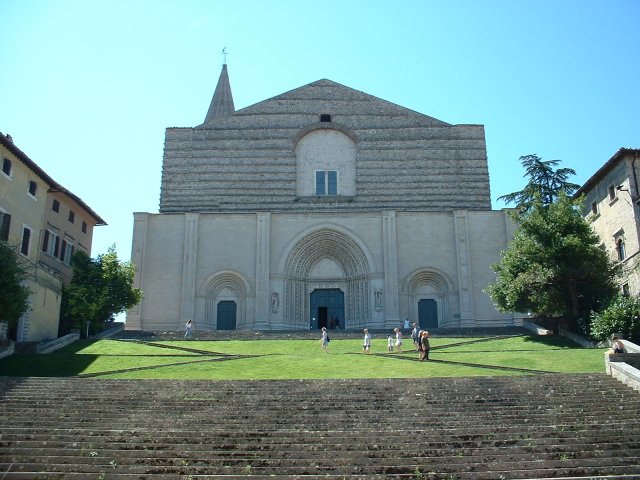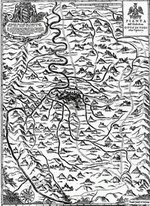Todi's country
The San Fortunato's church
Sacconi
Architect judged remainders of the VI-VII century the two lions in
stone a lot wear out from
the time, mails, one for side , on the first rung of the last slope of the staircase of access to
the Tempio di S. Fortunato and the vasca lustrale that is found to the income
of
tempio (the left side) constituted from a capital
in which is represented three witness of King (perhaps the King
Magi) from whose mouths exit shoot
and grape bunches. These remainders and the recovery of a little lead
plate , with on indicated year 707, found in a case of
travertino where was conserved the body of S. Fortunato, has made to
conclude that an ancient church in the place existed where rises today
the tempio of
From
the documents conserved in the Communal Archives of Todi it turns out
that 16 December 1291 the Common one made to estimate some houses to
acquire in order to erect a
temple to San Fortunato and that the 7
June 1292 came jetties the bases of the church.
The
Temple of San
Fortunato is the beautifulst existing Church in Todi and is to
be consider between the
huger and important constructions of the Umbria region.
Do not is know the architect of the Tempio :
the jobs, begun in the 1292, continued to along until the half
of the
xv siecle , age in which they came suspended, and since have
been never more resumed the work are still today unfinished .
The
construction of the Tempio has been lead in two times:
at first they came constructed the absidys
and it leave of the navate ones until the second brace of
columns; a simple wall
limited this first construction in order to allow to mass ;
the income happened through a door, today sluice, than it is
still noticed in the chiostro of annexed Ex-Convento.
The first brace of columns, towards the income, and the facade,
has been executed in according to time; in the external wall, towards
the chiostro, the union of the two walls is noticed easy;
the second construction appears more taken care of
especially in the preparation of the stone.
The
facade, of pure begun style gotico-italiano, to start build
in the 1415 and is incomplete:
the architect was Giovanni di Santuccio;
it died in the 1458, leaving the work unfinished
therefore as today we see it.
The portal is the
beautifulr part and more finished
than all the Tempio, it is between more arrogant beautiful than
how many they are to adorn the income of one Church.
The construction was begun in the 1420 and had term after
sixteen years of assiduous and diligent job.
The
inside of the Tempio goes back to the last ones of the sec.
XIII; is it with three aisles with supported from six columns
to fascioni, nimble and simple times to acute arc.
In the 1465 they were constructed, over the capitelli,
arches to it in the lateral navate
ones, to support of the columns which, were found, do not introduce a
perfect vertical line but there is who supports that the overhanging
it has been purposely executed to static scope.
In
the skillful navata one seven nails head are opened, in left the six;
to right, in bottom, there is, an other nail head with a great
baroque altar; the table
to oil of this altar is of the painter todino To Polinori (1618).
The bell tower, which it is approached from the sacristy
for a comfortable scale in masonry of one hundred six steps,
was completed in the 1460. The
chorus, kind expression of late rebirth (1590), work very valuable
of the Maffei by Gubbio.
The first three stalls for every side are complete and nearly
complete it is that headquarters.

La chiesa di san Fortunato
L'Architetto
Sacconi giudicò avanzi del VI-VII secolo i due leoni in pietra molto
consunti dal tempo, posti , uno per lato,sul primo scalino dell'
ultima rampata della scalea d'accesso al Tempio di S. Fortunato e la
vasca lustrale che si trova all'ingresso del tempio (lato sinistro)
costituita da un capitello nel quale sono raffigurate tre teste di Re
( forse i Re Magi ) dalle cui bocche escono tralci di vite e grappoli di uva.
Questi avanzi ed il rinvenimento di una piastrina plumbea, con su
indicato l'anno 707, trovata in una cassa di travertino ove era
conservato il corpo di S. Fortunato, hanno fatto concludere che
esisteva un' antichissima chiesa nel luogo ove sorge oggi il tempio di
S. Fortunato.
Dagli
atti conservati nell'Archivio Comunale di Todi risulta che il 16
Dicembre 1291 il Comune fece stimare alcune case da acquistare per erigere un tempio a S. Fortunato
e che il 7 Giugno 1292 vennero gettate le basi della chiesa .
II
Tempio di S. Fortunato è la più bella Chiesa esistente in Todi ed è
da considerarsi fra le costruzioni più grandiose ed importanti della
regione Umbria. Non si conosce l' architetto del Tempio : i lavori,
iniziati nel 1292, continuarono a lungo fino alla metà del sec. xv ,
epoca in cui vennero sospesi, e poiché
sono stati mai più ripresi l'opera è ancor oggi incompiuta.
La
costruzione del Tempio è stata condotta in due tempi: in un primo
tempo vennero costruite l' abside e parte delle navate fino alla
seconda coppia di colonne; un semplice muro limitò questa prima
costruzione per permettere di officiare le messe
; l'ingresso avveniva attraverso una porta, oggi chiusa, che si
scorge ancora nel chiostro dell'annesso ex-Convento. La prima coppia
di colonne, verso l'ingresso, e la facciata, sono state eseguite in un
secondo tempo ; nella parete esterna, verso il chiostro, si scorge
facilmente l' unione dei due muri; la seconda costruzione appare più
accurata specialmente nella preparazione della pietra.
La
facciata, di puro stile gotico-italiano,fu iniziata nel 1415
ed è incompleta : l’ architetto
fu Giovanni di Santuccio; egli morì
nel 1458, lasciando l'opera incompiuta così come oggi la
vediamo . Il portale è la parte più bella e più rifinita di tutto
il Tempio , esso è tra i
più superbamente belli di quanti stanno ad adornare l' ingresso di
una Chiesa. La costruzione fu iniziata nel 1420 ed ebbe termine dopo
sedici anni di lavoro assiduo e diligente.
L'interno
del Tempio risale agli ultimi del sec. XIII; è a tre navate con volte
ad arco acuto sostenute da sei colonne a fascioni, snelle e semplici.
Nel 1465 furono costruiti, sopra i capitelli, gli archi nelle navate
laterali, a sostegno delle colonne le quali, fu rilevato, non
presentano una perfetta linea verticale ma c' è chi sostiene che lo
strapiombo sia stato appositamente eseguito a scopo statico.
Nella navata destra si aprono sette cappelle, nella sinistra sei; a destra, in fondo, vi è, un' altra cappella con un grande altare barocco; la tavola ad olio di questo altare è del pittore todino A. Polinori (1618). Il campanile, cui si accede dalla sagrestia per una comoda scala in muratura di cento sei gradini, fu compiuto nel 1460. Il coro, gentile espressione della tarda rinascita (1590), opera pregevolissima del Maffei di Gubbio. i primi tre stalli per ogni lato sono completi e quasi completo è quello centrale.
